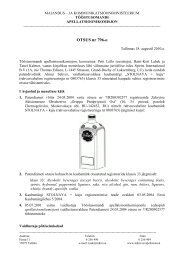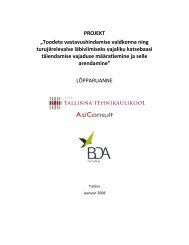Feasibility study for an Estonian Materials Technology Programme
Feasibility study for an Estonian Materials Technology Programme
Feasibility study for an Estonian Materials Technology Programme
You also want an ePaper? Increase the reach of your titles
YUMPU automatically turns print PDFs into web optimized ePapers that Google loves.
51<br />
<strong>Feasibility</strong> <strong>study</strong> <strong>for</strong> <strong>an</strong> Estoni<strong>an</strong> <strong>Materials</strong> <strong>Technology</strong> <strong>Programme</strong><br />
2. <strong>Materials</strong> technology in Estonia<br />
The projects are funded by the commission <strong>an</strong>d the research is done in, i.e. subcontracted from, a couple of<br />
universities. Esfil Techno gets the IPR. Also the Europe<strong>an</strong> partners in the projects are seen as very import<strong>an</strong>t contacts.<br />
Esfil Techno has tried to collaborate with Tallinn Technical University but has not found the right partners.<br />
Lessons learned/key success factors from the interview<br />
Currently the comp<strong>an</strong>y suffers from the machinery getting old <strong>an</strong>d inefficient – large investments are<br />
soon needed.<br />
Sales <strong>an</strong>d marketing of the technology also requires more ef<strong>for</strong>t.<br />
The technology is almost too good <strong>for</strong> the current products. How to successfully find new partners <strong>an</strong>d<br />
applications?<br />
Contact <strong>an</strong>d more in<strong>for</strong>mation: Araik Karapetj<strong>an</strong>, CEO esfiltehno@esfiltehno.ee<br />
2.5<br />
Adv<strong>an</strong>ced materials technologies: Commercialisation <strong>an</strong>d technology tr<strong>an</strong>sfer<br />
2.5.1 Overview<br />
There are several interesting comp<strong>an</strong>ies in Estonia developing <strong>an</strong>d m<strong>an</strong>ufacturing high technology products<br />
based on adv<strong>an</strong>ced materials <strong>an</strong>d a lot of relev<strong>an</strong>t activities are on-going at universities that may result in new<br />
adv<strong>an</strong>ced materials inventions in the future with signific<strong>an</strong>t potential <strong>for</strong> technology tr<strong>an</strong>sfer. In addition to<br />
research <strong>an</strong>d development activities, there are already some well-established areas related to materials technologies<br />
in Estonia.<br />
This section discusses the state of various adv<strong>an</strong>ced materials technologies in Estonia taking into account<br />
research <strong>an</strong>d development activities per<strong>for</strong>med at universities <strong>an</strong>d research institutions as well as technology<br />
development done at start-up comp<strong>an</strong>ies <strong>an</strong>d more established enterprises. The section is org<strong>an</strong>ised according<br />
to the estimated <strong>Technology</strong> Readiness Level of the Estoni<strong>an</strong> materials technologies. <strong>Technology</strong> Readiness<br />
Level is a tool <strong>for</strong> measuring technology maturity <strong>an</strong>d assessing technology related risks. It is used by several<br />
international org<strong>an</strong>isations such as NASA <strong>an</strong>d ESA.<br />
<strong>Technology</strong> Readiness Level scheme used <strong>for</strong> this <strong>study</strong> is based on five levels <strong>an</strong>d the scheme is currently<br />
implemented by EU FP7 fin<strong>an</strong>ced project ObservatoryNANO that uses it <strong>for</strong> assessing the readiness <strong>an</strong>d impact<br />
of various n<strong>an</strong>otechnologies <strong>for</strong> the Europe<strong>an</strong> economy. The levels in the scheme are:<br />
Fundamental research (TRL 1)<br />
Applied research (TRL 2)<br />
Prototype (TRL 3)<br />
Market entry (TRL 4)<br />
Mature markets (TRL 5)<br />
Fundamental research is typically conducted at universities <strong>an</strong>d research institutes <strong>an</strong>d focuses on <strong>study</strong>ing<br />
e.g. materials properties <strong>an</strong>d characterisation. From fundamental research phase, it may typically take 5-20<br />
years to reach the market with a new product.<br />
Applied research is done in the interface between comp<strong>an</strong>ies <strong>an</strong>d universities. It focuses on <strong>study</strong>ing <strong>an</strong>d<br />
developing materials <strong>for</strong> <strong>an</strong> already identified application <strong>an</strong>d the work typically results in, e.g., components<br />
or materials that solve some problem in the industry or offer a new material <strong>for</strong> <strong>an</strong> industrial application.<br />
Depending on the material <strong>an</strong>d industry application, it may take 2-10 years <strong>for</strong> a technology to enter the<br />
market from applied research phase.<br />
As the name suggests, prototype products me<strong>an</strong> industrially applicable products that are very close to the<br />
final solution to be sold in the market. <strong>Technology</strong> development activities focus on improving the products<br />
properties but most ef<strong>for</strong>t needed in the prototype phase is establishing the business <strong>an</strong>d starting sales activities.<br />
When the first prototypes have been produced, it typically takes 1-3 years to start commercial production.<br />
Market entry c<strong>an</strong> be considered to happen when the comp<strong>an</strong>y starts selling its products on a larger scale<br />
<strong>an</strong>d the business is expected to be profitable. Development activities are related to the improvement of the<br />
technology. In case of a completely new technology, there are often signific<strong>an</strong>t differences in the products of<br />
competing comp<strong>an</strong>ies.





